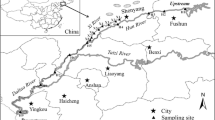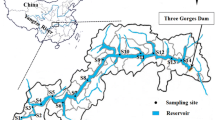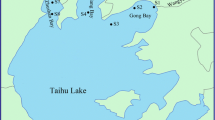Abstract
Free estrogens (estrone, E1; 17β-estradiol, 17β-E2; estriol, E3; and 17α-ethinylestradiol, EE2), their corresponding sulfate and glucuronide conjugates, and bisphenol A (BPA) were investigated in water and sediments in the Fen River catchment, an arid and semiarid area in northwest China. E1 and BPA were frequently detected in the wet and dry sampling seasons. In addition to the sulfate conjugates, other conjugated estrogens were not detected in water and sediments. The concentrations of these compounds in water generally increased from upstream to downstream. The concentrations in water samples of most sites were higher in the wet season than those in the dry season, but concentrations in sediments of most sites were higher in the dry season than those in the wet season. The distributions of these compounds in sediments were positively correlated with the total organic carbon (TOC) contents of sediments (0.3 < R 2 < 0.6, p < 0.01) and concentrations in water (0.25 < R 2 < 0.50, p < 0.01). In this catchment, E1 was the main contributor to endocrine disrupting risk. The surface water in most of the tributaries and the sewage in the drainage channels were at risk. The pore waters of sediments were at risk at most sampling sites.





Similar content being viewed by others
References
Arditsoglou A, Voutsa D (2010) Partitioning of endocrine disrupting compounds in inland waters and wastewaters discharged into the coastal area of Thessaloniki, Northern Greece. Environ Sci Pollut Res Int 17:529–538
Bu Q, Wang D, Xu Y, Hu J, Wang Z (2016) A risk-based screening approach for priority organic contaminants at the watershed scale: research and application. Asian J Ecotoxicol 11(1):126–132 (in Chinese)
Chang H, Wan Y, Wu S, Fan Z, Hu J (2011) Occurrence of androgens and progestogens in wastewater treatment plants and receiving river waters: comparison to estrogens. Water Res 45:732–740
Chen Q, Shi J, Wu W, Liu X, Zhang H (2012) A new pretreatment and improved method for determination of selected estrogens in high matrix solid sewage samples by liquid chromatography mass spectrometry. Microchem J 104:49–55
Fan Z, Hu J, An W, Yang M (2013) Detection and occurrence of chlorinated byproducts of bisphenol a, nonylphenol, and estrogens in drinking water of China: comparison to the parent compounds. Environm Sci Technol 47:10841–10850
Jenkins MB, Endale DM, Schomberg HH, Hartel PG, Cabrera ML (2009) 17β-Estradiol and testosterone in drainage and runoff from poultry litter applications to tilled and no-till crop land under irrigation. J Environ Manag 90:2659–2664
Jobling S, Williams R, Johnson A, Taylor A, Gross-Sorokin M, Nolan M, Tyler CR, van Aerle R, Santos E, Brighty G (2006) Predicted exposures to steroid estrogens in U.K. rivers correlate with widespread sexual disruption in wild fish populations. Environ Health Perspect 114:32–39
Johnson AC, Williams RJ, Matthiessen P (2006) The potential steroid hormone contribution of farm animals to freshwaters: the United Kingdom as a case study. Sci Total Environ 362:166–178
Kumar V, Nakada N, Yamashita N, Johnson AC, Tanaka H (2011) How seasonality affects the flow of estrogens and their conjugates in one of Japan’s most populous catchments. Environ Pollut 159:2906–2912
Laws SC, Carey SA, Ferrell JM, Bodman GJ, Cooper RL (2000) Estrogenic activity of octylphenol, nonylphenol, bisphenol A and methoxychlor in rats. Toxicol Sci 54(1):154–167
Lee LS, Strock TJ, Sarmah AK, Rao PSC (2003) Sorption and dissipation of testosterone, estrogens, and their primary transformation products in soils and sediment. Environ Sci Technol 37:4098–4105
Lei B, Huang S, Zhou Y, Wang D, Wang Z (2009) Levels of six estrogens in water and sediment from three rivers in Tianjin area, China. Chemosphere 76:36–42
Liu Z, Lu G, Yin H, Dang Z, Rittmann B (2015) Removal of natural estrogens and their conjugates in municipal wastewater treatment plants: a critical review. Environm Sci Technol 49:5288–5300
Lu GH, Song WT, Wang C, Yan ZH (2010) Assessment of in vivo estrogenic response and the identification of environmental estrogens in the Yangtze River (Nanjing section). Chemosphere 80:982–990
NBSC (National Bureau of Statistics of China) (2014a) Chinese environmental yearbook. China Statistic Press, Beijing
NBSC (National Bureau of Statistics of China) (2014b) China City statistical yearbook. China Statistic Press, Beijing
Nie M, Yang Y, Liu M, Yan C, Shi H, Dong W, Zhou JL (2014) Environmental estrogens in a drinking water reservoir area in Shanghai: occurrence, colloidal contribution and risk assessment. Sci Total Environ 487:785–791
Peng X, Yu Y, Tang C, Tan J, Huang Q, Wang Z (2008) Occurrence of steroid estrogens, endocrine-disrupting phenols, and acid pharmaceutical residues in urban riverine water of the Pearl River Delta, South China. Sci Total Environ 397:158–166
Reinen J, Suter MJF, Vögeli AC, Fernandez MF, Kiviranta H, Eggen RIL, Vermeulen NPE (2010) Endocrine disrupting chemicals—linking internal exposure to vitellogenin levels and ovotestis in Abramis brama from Dutch surface waters. Environ Toxicol Phar 30:209–223
Shappell NW, Elder KH, West M (2010) Estrogenicity and nutrient concentration of surface waters surrounding a large confinement dairy operation using best management practices for land application of animal wastes. Environ Sci Technol 44:2365–2371
Shi J, Liu X, Cao J, Bo T, Li Y (2013) Occurrence and risk assessment of estrogens and antiinflammatories in Baiyangdian Lake, North China. Environ Eng Manag J 12:1535–1543
Shi J, Liu X, Chen Q, Zhang H (2014) Spatial and seasonal distributions of estrogens and bisphenol A in the Yangtze River Estuary and the adjacent East China Sea. Chemosphere 111:336–343
Shrestha SL, Casey FXM, Hakk H, Smith DJ, Padmanabha G (2012) Fate and transformation of an estrogen conjugate and its metabolites in agricultural soils. Ennviron Sci Technol 46:11047–11053
Xu Y, Xu N, Llewellyn NR, Tao H (2014) Occurrence and removal of free and conjugated estrogens in wastewater and sludge in five sewage treatment plants. Environ Sci Proc Impacts 16:262–270
Wang L, Ying GG, Chen F, Zhang LJ, Zhao JL, Lai HJ, Chen ZF, Tao R (2012) Monitoring of selected estrogenic compounds and estrogenic activity in surface water and sediment of the Yellow River in China using combined chemical and biological tools. Environ Pollut 165:241–249
Williams RJ, Johnson AC, Smith JJ, Kanda R (2003) Steroid estrogens profiles along river stretches arising from sewage treatment works discharges. Environ Sci Technol 37:1744–1750
Williams RJ, Keller VDJ, Johnson AC, Young AR, Holmes MGR, Wells C, Gross-Sorokin M, Benstead R (2009) A national risk assessment for intersex in fish arising from steroid estrogens. Environ Toxicol Chem 28:220–230
Sohoni P, Tyler CR, Hurd K, Caunter J, Hetheridge M, Williams T, Woods C, Evans M, Toy R, Gargas M, Sumpter JP (2001) Reproductive effects of long-term exposure to bisphenol A in the fathead minnow (Pimephales promelas). Environ Sci Technol 35(14):2917–2925
MWRPRC (The Ministry of Water Resources of the People’s Republic of China) (2013) China water resource bulletin. http://www.mwr.gov.cn/zwzc/hygb/szygb/qgszygb/201411/t20141120_582980.html. Accessed 8 July 2016
Villeneuve DL, Garcia-Reyero N, Escalon BL, Jensen KM, Cavallin JE, Makynen EA, Durhan EJ, Kahl MD, Thomas LM, Perkins EJ, Ankley GT (2012) Ecotoxicogenomics to support ecological risk assessment: a case study with bisphenol A in fish. Environ Sci Technol 46:51–59
YRCC (Yellow River Conservancy Commission) (2013) Yellow River sediment bulletin. http://www.yellowriver.gov.cn/nishagonggao/2013/index.html. Accessed 8 Feb 2016
Zhang QQ, Zhao JL, Ying GG, Liu YS, Pan CG (2014) Emission estimation and multimedia fate modeling of seven steroids at the river basin scale in China. Environ Sci Technol 48:7982–7992
Zhou LJ, Zhang BB, Zhao YG, Wu QL (2016) Occurrence, spatiotemporal distribution, and ecological risks of steroids in a large shallow Chinese lake, Lake Taihu. Sci Total Environ 557–558:68–79
Acknowledgements
This study was supported by Shanxi Province Science and Technology Foundation (2013011040-7). The authors also acknowledge supports by the National Nature Science Foundation of China (51609058), the China Postdoctoral Science Foundation (2016M602009), and the Fundamental Research Funds for the Central Universities (JZ2015HGBZ0528; JZ2016HGTA0681).
Author information
Authors and Affiliations
Corresponding author
Additional information
Responsible editor: Roland Kallenborn
Electronic supplementary material
ESM 1
Detailed descriptions of the information of the sampling sites, the recoveries and method detection limits of these EDCs in water and sediments, estimated concentrations of estrogens and BPA in the pore water of sediments, and the relationships between E1 and BPA in sediments and those in water. (DOCX 70 kb)
Rights and permissions
About this article
Cite this article
Liu, X., Shi, J., Bo, T. et al. Distributions and ecological risk assessment of estrogens and bisphenol A in an arid and semiarid area in northwest China. Environ Sci Pollut Res 24, 7216–7225 (2017). https://doi.org/10.1007/s11356-017-8434-6
Received:
Accepted:
Published:
Issue Date:
DOI: https://doi.org/10.1007/s11356-017-8434-6




